| Some Stuff |
|
| Some MORE Stuff |
|
|
| Benign Positional Vertigo |
| This is another problem in the inner ear characterized by sudden occurrence of dizziness or a spinning sensation when the head is moved. The semicircular canals which are found in the inner ear normally contain fluid the movement of which helps the brain detect body position and maintain balance. As we age, or after a head injury, or after an inner ear infection, or any other disorder affecting the inner ear, small calcium carbonate crystals called otoconia or otoliths collects in a part of the inner ear called the utricle. They are normally attached to a membrane inside the utricle. What causes the vertigo? In BPPV, a change in head position cause these crystals to move through the semicircular canal. They strike against nerve endings inside thus causing the vertigo. Aside from vertigo the person may also feel dizzy, lightheaded, with a sense of imbalance, and nausea. If the condition is severe there is also vomiting. 
A maneuver called “Epley’s maneuver” is usually done to move otoconia away from the semicircular canals. After the procedure, the individual needs to maintain head in an upright position for 24 hours. Medications can also be given like sedative-hypnotics, antihistamines, and anticholinergics to alleviate the symptoms.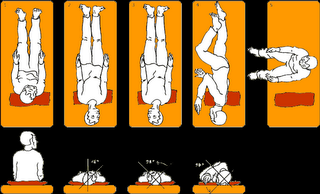
|
|
|
|
| Labyrinthitis |
The labyrinth is a system of interconnecting cavities and canals found in the inner ear concerned with hearing and balance. When this area becomes inflammed then there is this condition called labyrinthitis. This condition is commonly seen following infection of the middle ear, whether viral or bacterial, respiratory infection, allergy, or intake of drugs that are toxic to the inner ear structures. One of these structures is the semicircular canals which is concerned with balance and equilibrium. When its function becomes disrupted, this will lead to the different signs and symptoms like dizziness and abnormal sensation of movement or vertigo. The vertigo is acute in onset. It is usually noted upon sudden rising from the bed or just by turning oneself while in bed. It is often referred to as a spinning sensation and often accompanied by nausea and vomiting. There is also lost of balance, hearing loss, and an intense ringing sound in the affected ear (tinnitus). Early treatment of a respiratory infection or a middle ear infection is needed for prevention of this condition. Treatment includes use of antibiotics if there is bacterial infection, antihistamines for allergy, and other medications for the different symptoms noted. Rest is very important during the illness. Failure to treat the condition might lead to spread of inflammation and although rare, might end in permanent hearing loss. |
|
|
|
| Otitis media |
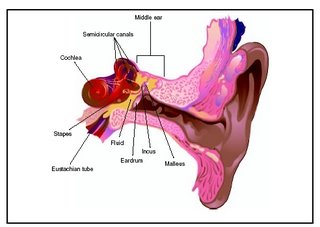 This is an acute infection of the middle ear characterized by the presence of fluid coupled with inflammation. The middle ear is the second part of the ear where the eardrum and the three tiny bones called ossicles are located. When sound waves reach the middle ear, the eardrum vibrates and the vibration is amplified by the ossicles bringing them to the inner ear which translates these vibrations into electrical signals. Connecting the middle ear to the back of the throat is a small tube called the Eustachian tube. This tube serves to equalize the pressure between the middle ear and the outside. It also serves as drainage for fluid or mucus that gets into the middle ear. This is an acute infection of the middle ear characterized by the presence of fluid coupled with inflammation. The middle ear is the second part of the ear where the eardrum and the three tiny bones called ossicles are located. When sound waves reach the middle ear, the eardrum vibrates and the vibration is amplified by the ossicles bringing them to the inner ear which translates these vibrations into electrical signals. Connecting the middle ear to the back of the throat is a small tube called the Eustachian tube. This tube serves to equalize the pressure between the middle ear and the outside. It also serves as drainage for fluid or mucus that gets into the middle ear.
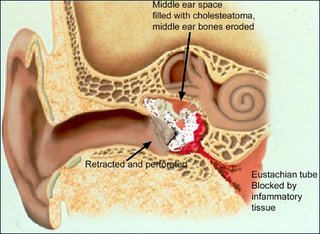 How does the middle ear gets infected? This condition is usually noted after an upper respiratory tract infection whether viral or bacterial. The infection causes obstruction of the Eustachian tube allowing negative pressure to be generated inside the middle ear. This blockage will allow fluid to build up which is a fertile media for growth of microorganisms. This also entraps bacteria or virus that are already present inside due to the respiratory tract infection. If this infection remains untreated,this will cause rupture of the eardrum and/or extension of the infection to the inner ear structures. How does the middle ear gets infected? This condition is usually noted after an upper respiratory tract infection whether viral or bacterial. The infection causes obstruction of the Eustachian tube allowing negative pressure to be generated inside the middle ear. This blockage will allow fluid to build up which is a fertile media for growth of microorganisms. This also entraps bacteria or virus that are already present inside due to the respiratory tract infection. If this infection remains untreated,this will cause rupture of the eardrum and/or extension of the infection to the inner ear structures.
This condition is common in children because their Eustachian tube is narrower, shorter, and more horizontal. The most common symptom is pain on the affected ear because of fluid pushing on the eardrum accompanied by difficulty of hearing. There may or may not be fever. The condition becomes chronic if it lasts for more than 6 weeks. Four or more episodes in one year makes it a recurrent condition.
The condition is treated with antibiotics and analgesics. It must be differentiated with otitis media with effusion which is a condition characterized by presence of fluid in the middle ear but its not infected hence antibiotics are not necessary. |
|
|
|
| Otitis Externa |

This is an infection of the ear canal due to a bacteria or fungus. It happens when water gets into the ears and becomes trapped inside. Water has a tendency of removing the ear wax which serves as protection and it also cause the skin to macerate. This leads to growth of bacteria and fungus which leads to the signs and symptoms seen in otitis externa. Another means is by damage to the skin in the ear canal which usually happens after cleaning with cotton buds, hair clips, and the like. The damaged skin becomes the breeding ground for fungus and bacteria. other causes include scratching the skin in ear canal or excessively dry skin in the canal which can easily break and get infected. Otitis externa is commonly seen during the summer months. Swimming is a common activity during this season. A person with this condition usually encounters earache following a swimming episode that’s why this condition is also known as swimmer’s ear. The pain becomes during chewing and ipon traction of the pinna. Aside from the pain there is also itchiness in the area and sometimes there is swelling accompanied by reddening of the ear canal. Hearing can be temporarily affected because of the swelling. Ear discharge may or may not be present. The patient should be given ear drops containing antibiotic to combat infection as well as steroids for the inflammation. If the condition is severe oral medications are advisable to be taken for 7 to 10 days. The ears should be kept dry all the time to prevent this condition from occurring. |
|
|
|
| Undescended Testis |
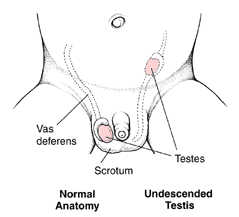
The testicles normally develop inside the abdominal cavity before birth. They descend into the scrotal sac by the 7th to 9th month of fetal development for optimal sperm production. Failure to do so before birth leads to the condition known as undescended testes or cryptorchidism. It can be in one side only or it can be bilateral. The most common cause is prematurity although this condition is also seen in 3% of full-term male infants. Other causes include hormonal disorders, genetics, and spina bifida. No symptoms are associated with this condition. It is usually discovered during routine medical history and physical examination. The undescended testis is expected to descend without any intervention by the 6th month of age. If by this time it still has not descended then it may not descend at all.Something has to be done to avoid complications later on. One of these complications which is the most common especially if the condition is bilateral is infertility. There is also risk of developing testicular cancer when the child reaches adulthood. The most bothersome effect to the growing child is the psychological aspect of having an empty scrotum. Pharmacotherapy involves hormonal injections of HCG (human chorionic gonadotrophin) given for several weeks. This hormone is expected to stimulate testosterone production leading to the descend of the testis to the scrotal sac. Unfortunately this type of management is often not successful.When this happens surgical approach is recommended. Orchiopexy is the surgical method of bringing down the testis into the scrotum. This procedure is done preferably between the 6th to 18th month of age. The earlier it is accomplished the better to prevent damage to the germ cells. Sometimes the testis can be felt inside the scrotum but sometimes it is not. This condition is different from the undescended testis that we are discussing. This is due to the cremasteric reflex that contraction of the muscle causes retraction of the testicle. It is called retractile testes. |
|
|
|
| Multiple Sclerosis |

MS is a disorder of the brain, spinal cord, and optic nerves. This condition results in damage of the myelin sheath, the nerve covering which helps in the conduction of impulses.When the myelin is damaged this leads to impairment in the transmission of nerve signals producing problems in thinking, sensation, and movement.
This condition is seen more in women. The cause is still unknown but many researchers believe it is an autoimmune disease, meaning the immune system attacks its own tissues.The damage in the myelin occur in patches. The type of symptoms depend on the area of damage. These symptoms appear in different combinations from one person to another probably because of differences in the location of damage. They are seen in individuals 20-40 years of age.
Visual problems include a double or blurred vision, distorted color perception, eye pain, and blindness of affected eye. These visual problems can be accompanied by difficulty of concentration, poor memory, depression, muscle weakness, problems with balance and coordination, abnormal sensations like numbness. When the condition is severe there can be problems in standing or walking, or even paralysis.
There is no treatment available for this condition. The drugs are there to alleviate symptoms and probably to slow down its progression. Some of this drugs include steroids, muscle relaxants, tranquilizers, and anti-depressants.Physical therapy and exercise is also recomended as add-on to lessen the stiffness of the muscles. |
|
|
|
| Jellyfish Stings |
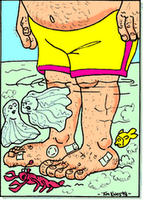
Jellyfishes are invertebrate aquatic animals that cause sting when a person comes into direct contact with their tentacles. These tentacles have specialized stinging cells called nematocytes which contain stinging structures called nematocysts. Sharp hollow tubes containing poison are found in the nematocysts. This poison is released and injected into the skin when a person suddenly comes into direct contact with the tentacles. The toxin cause abnormalities in calcium anf sodium ion transport, releases inflammatory mediators, disrupts the membrane of cells, and affects the tissues of the heart, kidneys, nerves, and liver.It causes local skin reactions like a red rash that is both itchy and painful, swelling, and peeling off of the skin if the condition is severe. Severe systemic reaction include headache, vomiting, weakness, dyspnea, muscle spasms, fever and chills. It can even lead to shock and sudden death. Depending on the type of jellyfish, the effect of the poison differ. The faster the poison gets into the bloodstream, the more concentrated it is in the blood and the faster the onset of signs and symptoms. When a person comes into contact with jellyfish, remove him immediately from the water. Immobilize the area so as not to spread the poison further and wash the area with salt water. Inspect the affected area for any tentacles that are still attached to the skin and if there are any remove them with forceps. Apply white vinegar to inactivate undischarged nematocysts. This will also help alleviate the symptoms.Give supportive medications for the symptoms and if there is a need hook the patient to IV fluids. Topical steroids can be applied for severe skin reactions. |
|
|
|
| Hiccup |
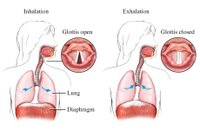
Medically known as singultus, hiccups occur due to involuntary spasm of the diaphragm and causes it to contract repeatedly. The spasms also cause sudden rush of air into the lungs which is stopped suddenly by the closure of the vocal cords or glottis. The sudden closure results in the characteristic “hic” sound. Hiccups last for several minutes to several hours and normally resolves by itself. If it becomes persistent (lasts more than 48 hours) or intractable (lasts for more than a month) then it may be a sign of a more serious health condition. The actual cause of hiccups is still unknown. Studies show that it results from irritation, from eating too much too quickly, excessive alcohol drinking, excitement, eating very spicy foods, drinking a cold beverage with a hot meal or vise versa, laughing vigorously, and smoking. There are a number of home remedies thought of to improve the condition or at least lessen its occurence. Some of these include holding your breath and slowly counting to 10, putting sugar or honey under your tongue, breathing repeatedly into a paper bag or in a small enclosed container, and drinking quickly a glass of cold water. All of these home remedies increase the level of carbon dioxide in the blood. The better method is exhaling all the air inside the lungs in one long exhalation and this is followed by breathing in all the air in one long inhalation with a series of short powerful puffs at the end of inspiration until the lungs cannot hold anymore. The breath is further held for several minutes or as long as possible. For the persistent and intractable types, treatment is directed to the particular cause. This may range from use of medicines to hypnosis. Medically they are given haloperidol,chlorpromazine, metoclopramide, or baclofen. |
|
|
|
|
|